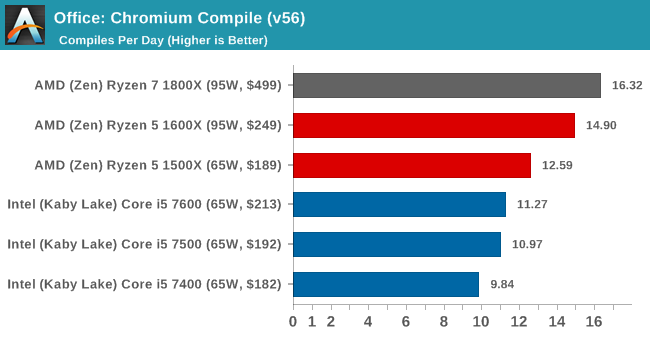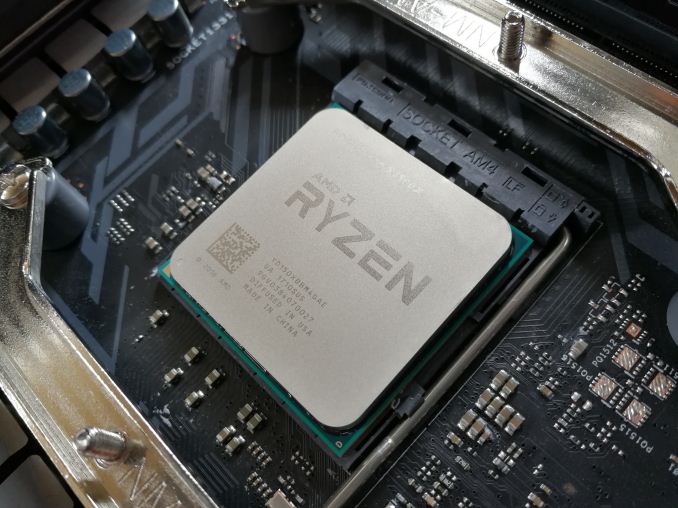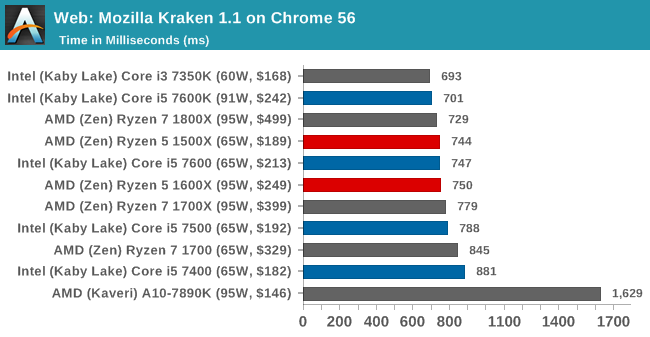The AMD Ryzen 5 1600X vs Core i5 Review: Twelve Threads vs Four at $250
by Ian Cutress on April 11, 2017 9:00 AM ESTAMD Ryzen 5
We mentioned at the top of the review that AMD’s Ryzen 7 launch last month benefited in a market where the competition was extremely expensive – being able to offer equivalent performance in most tasks and then undercut the competition by 50% is a difficult task, but the opening was always there due to a lack of competition in this space. When it comes to the mainstream market, the Ryzen 5 processors are actually competing on price with Intel’s processors directly, and thus has to offer something more to compete.
We have already shown in previous reviews that the Zen microarchitecture from AMD is around the equivalent of Intel’s Broadwell microarchitecture, but at this lower price point we have AMD’s Zen against Intel’s Kaby Lake, which is two generations newer than Broadwell and affords a comfortable IPC uplift over Broadwell. Given AMD’s monolithic design strategy of a single silicon die catering for most of their product line (well, all of it so far), the way AMD is tackling this is through more cores.
Before the debate about cores from AMD’s past rears its head (Vishera/Bulldozer designs in that case), given that AMD’s single thread performance is not too far behind, having a big set of cores as an alternative is something interesting for end-users, especially as more work flows and gaming titles rely on multithreading to scale. As a result, where Intel offer four cores and four threads, AMD is now offering six cores and twelve threads – a potential +200% uptick in the number of threads and +50% in cores, albeit at 10-15% lower instructions per clock.
(There’s also a side argument here about die sizes and wafer costs to each company to consider, but we will leave that for a different piece.)
For this review, based on time and available parts, we tested the Ryzen 5 1600X six-core processor against a set of Intel Core i5 parts that users might also be considering. We have some Ryzen 5 1500X quad-core numbers in here as well, and that might be spun out into a separate review at a later date. We also demonstrated our new 2017 CPU gaming tests, with four GPUs, six tests, two resolutions per test, and a couple of extra extreme resolution tests.
On The Benchmark Results
Looking at the results, it’s hard to notice the effect that 12 threads has on multithreaded CPU tests. The usual culprits show big wins for AMD here: 2D to 3D photo conversion, ray tracing, Blender, Cinebench, Encryption and video transcoding are all sizable wins. This is the sort of workload in which moving up to the Ryzen 7 CPUs, budget permitting, also do well on.
A new test in our suite for this review is a Compile Chromium test on Windows. As part of our testing suite, we have a fixed nightly download from mid-March and set this to compile, taking the final time and converting it into how many compiles per day. For around $250, Ryzen is the only way to go:

As you would expect, AMD still lags in IPC to Intel, so a 4.0 GHz AMD chip can somewhat compete in single threaded tests when the Intel CPU is around 3.5-3.6 GHz, and the single thread web tests/Cinebench results show that.
On The Gaming
Our gaming tests are a mix of Full-HD and 4K testing, some of which ends up being more CPU limited than we expected.
Civilization, at both 1080p and 4K Ultra settings, seem to scale quite happily with more cores on all GPUs, except the GTX 1060 at 4K. It’s worth noting situations such as the R9 Fury at 1080p Ultra only has 920ms under 60 FPS on the 1600X, compared to 6300 milliseconds on the Core i5-7600.
Shadow of Mordor leans towards the higher IPC of Intel, as the DX11 title cannot take advantage of the cores as much. Rise of the Tomb Raider’s benchmark is notorious for having each of its three seconds perform differently with respect to CPU scaling, with the Prophets scene being more CPU limited than the rest of the stage in the game.
Rocket League using an AMD CPU + AMD GPU actually provides more equal results with NVIDIA GPUs, however there's a performance drop using Ryzen + NVIDIA, which potentially correlates towards a driver bug but we're not 100% sure what is going on. Grand Theft Auto is a mixed bag, despite being a DX11 title – in some situations the Ryzen 5 is ahead of the Intel CPUs, or they all perform about the same, or the Intel CPUs pull ahead.
I have $250, What Should I Get – the Core i5 7600/7600K or the Ryzen 5 1600X?
Platform wise, the Intel side can offer more features on Z270 over AM4, however AMD would point to the lower platform cost of B350 that could be invested elsewhere in a system.
On performance, for anyone wanting to do intense CPU work, the Ryzen gets a nod here. Twelve threads are hard to miss at this price point. For more punchy work, you need a high frequency i5 to take advantage of the IPC differences that Intel has.
For gaming, our DX12 titles show a plus for AMD in any CPU limited scenario, such as Civilization or Rise of the Tomb Raider in certain scenes. For e-Sports, and most games based on DX9 or DX11, the Intel CPU is still a win here.












254 Comments
View All Comments
Icehawk - Tuesday, April 11, 2017 - link
Good point, my company isn't going to spend more for an AMD system for our regular users and a video card (even junk) would likely tip the cost against them. I do think some of our devs might like these and there we can justify the extra $.Krysto - Wednesday, April 12, 2017 - link
Ryzen APUs are coming.deltaFx2 - Tuesday, April 11, 2017 - link
@jrs77: Talk about strawman arguments. "as the most used software is still singlethreaded " Just because you vehemently assert it doesn't make it true. All the MT workloads tested in Ian's suite are real workloads people use. I have 14 "Chrome Helper" threads running on my laptop as I type this, just to point out the obvious. The software that continues to be single threaded are the ones in which the cost of a MT implementation outstrips the gain. Office is 1T (I'll take your word for it) because it works perfectly fine on Atom or Excavator. I don't think Photoshop is a workload that holds up people most of the time either. Here's the other thing: Folks who have Photoshop for a living also likely do video editing, rendering and so forth. Sometimes at the same time as photoshop. See Ian's review of various workloads that do this.iGPU: That is fair point for the 4c part. For the hex-core, you're getting into the same usage space as the 8c: content creators. Then again, who buys desktops these days for office work? Most offices I know of give their employees laptops + docking stations. It's only gamers and content creators, CAD folks that buy laptops. These guys also buy graphics cards to go with their rig.
psychobriggsy - Wednesday, April 12, 2017 - link
One benchmark that used to be done was multiple apps at the same time.For example, a browser benchmark running alongside a video encode.
This can show real world use cases a lot better. Also it would show off better MT implementations better, in this case Ryzen would fare a lot better (either by having SMT in the 4C8T, or have more cores and SMT in the 6C12T) even where the Intel equivalent would do okay when doing 1 task only.
masouth - Wednesday, April 12, 2017 - link
to add onto that, even certain tools/ functions in Photoshop are multi-threaded. Most blurs are as well as color mode conversions just to name a couple.as usual, YMMV depending on how often you use those but it IS there and more cores/threads offers a very real benefit for people that do use them.
Meteor2 - Wednesday, April 12, 2017 - link
Most users could easily get by with Celerons. I'm not sure what your point is.ChubChub - Tuesday, April 11, 2017 - link
At $250 what should you get? A 1400, and use the extra cash + saved cash on the motherboard to get a better GPU.davide445 - Tuesday, April 11, 2017 - link
1600x or 1600 will be part of my new rig.Really clear from this review AMD does optimize his CPU for serious tasks (where lie the real lasting grow in the PC market) and modern gaming titles (DX12, the future), leaving a sufficient to good performance to the others.
Minimizing production costs can profit for sales and sustain Intel possible dumping activities.
IMHO a clever strategy, since they didn't need to serve ALL the market, but just being able to lead the most profitable, that's for sure not the casual e-Sport gamer.
ImperfectLink - Tuesday, April 11, 2017 - link
Cinebench 10 and 11.5 tables are mixed up. It's 11.5 first with the decimals and 10 with the thousands.farmergann - Tuesday, April 11, 2017 - link
You choose to finish the article with, "...the Intel CPU is still a win here." A sentence that simply doesn't belong in any Ryzen vs sky/kaby comparison, much less as the final statement. What a joke of a shill you must be. BTW, your own testing reveals that tasks and games truly dependent on single thread IPC find Broadwel DT the victor over newer intel garbage, yet you mention Broadwell here as though it were dated... pitiful.